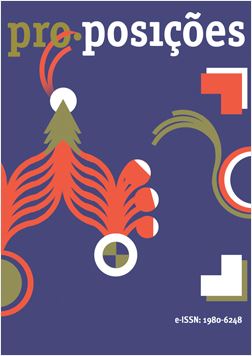Resumo
Este artigo continua os esforços de Vygotsky em investigar a gênese social da generalização afetiva na criação da arte e no processo de recepção proposto em Sobre o problema da psicologia do trabalho criativo do ator. A generalização afetiva abstrai emoções e sentimentos do plano individual para o social e do mundano para o nível hipergeneralizado. Com base no exame das ideias estéticas de Vygotsky, apresentamos o trabalho do filósofo chinês Defeng Wang em filosofia da arte sob a abordagem existencial. Na última parte, também propomos adotar o arcabouço da psicologia cultural da mediação semiótica para capturar esse processo dinâmico.
Referências
Heggstad, K. M. (2019). 7 paths to drama in education (M. Y. Wang & Z. Wang, trans.). East China Normal University Press
Heidegger, M. (2002). Off the beaten track (J. Young & K. Haynes, trans.). Cambridge University Press.
Larrain, A., & Haye, A. (2020). The dialogical and political nature of emotions: A reading of Vygotsky’s The Psychology of Art. Theory & Psychology, 30(6), 800-812.
Leontiev, A. N. (1971). Introduction. In The psychology of art (Scripta Technica, Inc., Trans). MIT Press.
Pelias, R. (2004). A methodology of the heart. Evoking Academic and Daily Life Rowman Altamira Press.
Valsiner, J. (2006). The Overwhelming World: Functions of Pleromatization in Creating Diversity in Cultural and Natural Constructions [Keynote Lecture]. International Summer School of Semiotic and Struc-tural Studies, Imatra, Finland.
Valsiner, J. (2013). Creating sign hierarchies: Social representation in its dynamic context. Papers on Social Representations, 22(16), 1021-5573.
Valsiner, J. (2014). An invitation to cultural psychology Sage.
Valsiner, J. (2015). The place for synthesis: Vygotsky’s analysis of affective generalization. History of the human sciences, 28(2), 93-102.
Valsiner, J. (2018). Human psyche between the mundane and the aesthetics: The sublime as the arena for semiosis. In M. C. D. P. Lyra, & M. A. Pinheiro (Orgs.), Cultural psychology as basic science dialogues with Jaan Valsiner (pp. 43-56). Cham: Springer.
Valsiner, J. (2020). Sensuality in human living: The cultural psychology of affect Springer.
van der Veer, R., & Zavershneva, E. (2011). To Moscow with Love: Partial Reconstruction of Vygotsky’s Trip to London. Integrative Psychological & Behavioral Science, 45(4), 458-74.
Vigotski, L. S. (2023). Sobre a questão da psicologia da criação pelo ator. (P.N. Marques, Trad.). Pro-Posições, 34, ed0020210085. http://dx.doi.org/10.1590/1980-6248-2021-0085 (Original work published 1936).
Vygotsky, L. S. (1971). Psychology of art New York: MIT Press.
Vygotsky, L. S. (1999). On the problem of the psychology of the actor’s creative work. The collected works of LS Vygotsky, 6, 237-244.
Wang, D. F. (2005) Philosophy of art Fudan University Press.
Wu, X. M. (2001a). On the ontological basis of Marx’s philosophy. Academic Monthly, 9(90), 90-100.
Wu, X. M. (2001b). The existential approach in contemporary philosophy. Philosophy Study, (12), 9-11.

Este trabalho está licenciado sob uma licença Creative Commons Attribution-NonCommercial 4.0 International License.
Copyright (c) 2023 Pro-Posições


